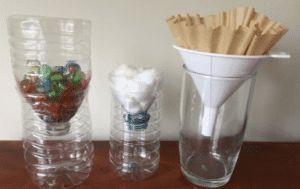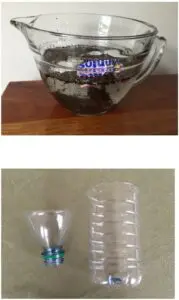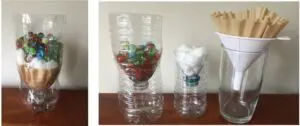Materials
Instructions
Students make “contaminated” water and design a filtering system to remove the pollutants.

 Part 1: Make your dirty water!
Part 1: Make your dirty water!
Make some polluted water by mixing water and several pollutants in a bowl. The exact proportions aren’t important.
Part 2: Design Your Filter
 If you have a large, 2-liter bottle you may be able to assemble your filter in one system. If you have small cups or bottles you can design a system where you treat the water one step at a time, pouring the results from one step into the next.
If you have a large, 2-liter bottle you may be able to assemble your filter in one system. If you have small cups or bottles you can design a system where you treat the water one step at a time, pouring the results from one step into the next.Test your Filtration System:
When you’re ready, test your design. How did it work?
Make Changes and Try Again!
Think about changes to your design, exploring different materials, or starting over! Engineers rarely get it right on the first try. They learn from their mistakes and keep trying.
Share Your Results with a Teacher, Parent/Guardian, or DiscoverE!
You can email photos to DiscoverE at social@DiscoverE.org
Enjoy this activity?
Join our community and receive activities, early access to programs, and other special news, and/or leave feedback on this activity below!
All of the content on this site is free!
Registering for the site helps us tailor future activities, webinars, and events so that we can serve you better.
Thank you for your interest and for helping us in our mission to transform lives as we put the E in STEM!
Thank you! Your submission is processing.